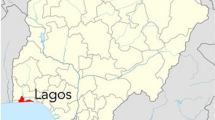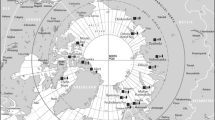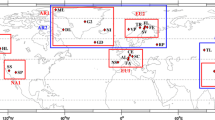Abstract
Atmospheric temperatures characterize Earth as a slow dynamics spatiotemporal system, revealing long-memory and complex behavior. Temperature time series of 54 worldwide geographic locations are considered as representative of the Earth weather dynamics. These data are then interpreted as the time evolution of a set of state space variables describing a complex system. The data are analyzed by means of multidimensional scaling (MDS), and the fractional state space portrait (fSSP). A centennial perspective covering the period from 1910 to 2012 allows MDS to identify similarities among different Earth’s locations. The multivariate mutual information is proposed to determine the “optimal” order of the time derivative for the fSSP representation. The fSSP emerges as a valuable alternative for visualizing system dynamics.
Similar content being viewed by others
References
S. I. Ahmed, R. Rudra, T. Dickinson, and M. Ahmed, Trend and periodicity of temperature time series in Ontario. American J. of Climate Change 3 (2014), 272–288.
D. Baleanu, K. Diethelm, E. Scalas, and J. J. Trujillo, Fractional Calculus: Models and Numerical Methods. World Scientific (2012).
I. Borg and P. J. Groenen, Modern Multidimensional Scaling-Theory and Applications. Springer-Verlag, New York (2005).
R. Bove, V. Pelino, and L. De Leonibus, Complexity in rainfall phenomena. Commun. in Nonlinear Sci. and Numer. Simulation 11, No 6 (2006), 678–684.
P. Brohan, J. J. Kennedy, I. Harris, S. F. Tett, and P. D. Jones, Uncertainty estimates in regional and global observed temperature changes: A new data set from 1850. J. of Geophysical Research: Atmospheres (1984-2012) 111, No D12 (2006).
T. F. Cox and M. A. A. Cox, Multidimensional Scaling. Chapman & Hall/CRC, Boca Raton (2001).
E. C. de Oliveira and J. Machado, A review of definitions for fractional derivatives and integrals. Mathematical Problems in Engineering 2014 (2014), Article ID 238459, 6 p.
C. Deser, A. S. Phillips, and M. A. Alexander, Twentieth century tropical sea surface temperature trends revisited. Geophysical Research Letters 37, No 10 (2010), Paper No 2010GL043321, 6 p.
L. Dorcak, Numerical models for the simulation of the fractional-order control systems. arXiv Preprint math/0204108 (2002).
D. Founda, K. Papadopoulos, M. Petrakis, C. Giannakopoulos, and P. Good, Analysis of mean, maximum, and minimum temperature in athens from 1897 to 2001 with emphasis on the last decade: trends, warm events, and cold events. Global and Planetary Change 44, No 1 (2004), 27–38.
S. Gakkhar and A. Singh. Complex dynamics in a prey predator system with multiple delays. Commun. in Nonlinear Sci. and Numer. Simulation 17, No 2 (2012), 914–929.
Q.-S. Ge, J.-Y. Zheng, Z.-X. Hao, X.-M. Shao, W.-C. Wang, and J. Luterbacher, Temperature variation through 2000 years in China: An uncertainty analysis of reconstruction and regional difference. Geophysical Res. Letters 37, No 3 (2010), Paper No 2009GL041281, 5 p.
J. Grieser, S. Trömel, and C.-D. Schönwiese, Statistical time series decomposition into significant components and application to european temperature. Theoretical and Applied Climatology 71, No 3–4 (2002), 171–183.
J. Hansen, R. Ruedy, M. Sato, and K. Lo, Global surface temperature change. Reviews of Geophysics 48, No 4 (2010), Paper No 2010RG000345, 29 p.
J. A. Hartigan, Clustering Algorithms. John Wiley & Sons, Inc. (1975).
P. Holoborodko, Smooth noise robust differentiators (2008). http://www.holoborodko.com/pavel/numerical-methods/numerical-derivative/smooth-low-noise-differentiators.
G. L. Hughes, S. S. Rao, and T. S. Rao, Statistical analysis and timeseries models for minimum/maximum temperatures in the Antarctic Peninsula. In: Proc. Royal Soc. of London A: Mathematical, Physical and Engineering Sci. 463, (2007), 241–259.
C. M. Ionescu, The Human Respiratory System: An Analysis of the Interplay Between Anatomy, Structure, Breathing and Fractal Dynamics. Springer Science & Business Media (2013).
M. Kenneth and B. Ross, An Introduction to the Fractional Calculus and Fractional Differential Equations. Wiley New York (1993).
J. Kruskal, Multidimensional scaling by optimizing goodness of fit to a nonmetric hypothesis. Psychometrika 29, No 1 (1964), 1–27.
J. B. Kruskal and M. Wish, Multidimensional Scaling. Sage Publications, Newbury Park (1978).
A. M. Lopes and J. T. Machado, Fractional order models of leaves. J. of Vibration and Control 20, No 7 (2014), 998–1008.
A. M. Lopes and J. T. Machado, State space analysis of forest fires. J. of Vibration and Control 2015 (2015), 12 p.; DOI: 10.1177/1077546314565687.
A. M. Lopes and J. T. Machado, Analysis of temperature time-series: Embedding dynamics into the MDS method. Commun. in Nonlinear Sci. and Numer. Simulation 19, No 4 (2014), 851–871.
A. M. Lopes and J. T. Machado, Dynamic analysis and pattern visualization of forest fires. Plos One 9, No 8 (2014), e105465.
A. M. Lopes, J. T. Machado, C. M. Pinto, and A. M. Galhano, Fractional dynamics and mds visualization of earthquake phenomena. Computers and Mathematics with Appl. 66, No 5 (2013), 647–658.
Y. Luo and Y. Chen, Fractional Order Motion Controls. John Wiley & Sons (2012).
J. T. Machado, A. M. Galhano and J. J. Trujillo, Science metrics on fractional calculus development since 1966. Fract. Calc. Appl. Anal. 416, No 2 (2013), 479–500; DOI: 10.2478/s13540-013-0030-y; http://www.degruyter.com/view/j/fca.2013.16.issue-2/issue-files/fca.2013.16.issue-2.xml.
J. T. Machado, V. Kiryakova, and F. Mainardi, Recent history of fractional calculus. Commun. in Nonlinear Sci. and Numer. Simulation 16, No 3 (2011), 1140–1153.
J. T. Machado and A. M. Lopes, Analysis and visualization of seismic data using mutual information. Entropy 15, No 9 (2013), 3892–3909.
J. T. Machado and A. M. Lopes, The persistence of memory. Nonlinear Dynamics 79, No 1 (2014), 63–82.
J. T. Machado and A. M. Lopes, Analysis of natural and artificial phenomena using signal processing and fractional calculus. Fract. Calc. Appl. Anal. 418, No 2 (2015), 459–478; DOI: 10.1515/fca-2015-0029; http://www.degruyter.com/view/j/fca.2015.18.issue-2/fca-2015-0029/fca-2015-0029.xml.
J. T. Machado, A. M. Lopes, F. Duarte, M.D. Ortigueira and R. Rato, Rhapsody in fractional. Fract. Calc. Appl. Anal. 417, No 4 (2014), 1188–1214; DOI: 10.2478/s13540-014-0206-0; http://www.degruyter.com/view/j/fca.2014.17.issue-4/issue-files/fca.2014.17.issue-4.xml.
F. Mainardi, Fractional Calculus and Waves in Linear Viscoelasticity: An Introduction to Mathematical Models. World Scientific (2010).
W. L. Martinez and A. R. Martinez, Exploratory Data Analysis with MATLAB. Chapman & Hall/CRC, Boca Raton (2005).
J. J. Oñate and A. Pou, Temperature variations in Spain since 1901: A preliminary analysis. International J. of Climatology 16, No 7 (1996), 805–815.
I. Petras, Fractional-Order Nonlinear Systems: Modeling, Analysis and Simulation. Springer Science & Business Media (2011).
C. M. Pinto, A. M. Lopes, and J. T. Machado, A review of power laws in real life phenomena. Commun. in Nonlinear Sci. and Numer. Simulation 17, No 9 (2012), 3558–3578.
I. Podlubny, Fractional Differential Equations. Academic Press, San Diego (1999).
J. W. Polderman and J. C. Willems, Introduction to Mathematical Systems Theory: A Behavioral Approach. Springer (1998).
C. E. Shannon, A mathematical theory of communication. ACM SIGMOBILE Mobile Computing and Communications Review 5, No 1 (2001), 3–55.
H. Sheng, Y. Chen, and T. Qiu, Fractional Processes and Fractional-Order Signal Processing: Techniques and Applications. Springer Science & Business Media (2011).
R. N. Shepard, The analysis of proximities: Multidimensional scaling with an unknown distance function. Psychometrika 27, No I and II (1962), 219–246 and 219–246.
M. F. Silva, J. Machado, and A. Lopes, Fractional order control of a hexapod robot. Nonlinear Dynamics 38, No 1–4 (2004), 417–433.
S. Srinivasa, A review on multivariate mutual information. Univ. of Notre Dame, Notre Dame, Indiana 2 (2005), 1–6.
D. B. Stephenson and F. J. Dolas-Reyes, Statistical methods for interpreting Monte Carlo ensemble forecasts. Tellus A 52, No 3 (2000), 300–322.
A. Strehl and J. Ghosh, Cluster ensembles-a knowledge reuse framework for combining multiple partitions. The J. of Machine Learning Research 3 (2003), 583–617.
J. Tenreiro Machado and A. M. Lopes, Dynamical analysis of the global warming. Mathematical Problems in Engineering 2012 (2012), Article ID 971641, 12 p.
W. Torgerson, Theory and Methods of Scaling. Wiley, New York (1958).
D. Valério, J. T. Machado and V. Kiryakova, Some Pioneers of the Applications of Fractional Calculus. Fract. Calc. Appl. Anal. 417, No 2 (2014), 552–578; DOI: 10.2478/s13540-014-0185-1; http://www.degruyter.com/view/j/fca.2014.17.issue-2/issue-files/fca.2014.17.issue-2.xml.
D. Valério, J. J. Trujillo, M. Rivero, J. Machado, and D. Baleanu, Fractional calculus: A survey of useful formulas. The European Physical J. Special Topics 222, No 8 (2013), 1827–1846.
R. Vassoler and G. Zebende, DCCA cross-correlation coefficient apply in time series of air temperature and air relative humidity. Physica A: Statistical Mechanics and its Applications 391, No 7 (2012), 2438–2443.
F. M. Viola, S. L. Paiva, and M. A. Savi, Analysis of the global warming dynamics from temperature time series. Ecological Modelling 221, No 16 (2010), 1964–1978.
Z. Wu, N. E. Huang, J. M. Wallace, B. V. Smoliak, and X. Chen, On the time-varying trend in global-mean surface temperature. Climate Dynamics 37, No 3–4 (2011), 759–773.
Author information
Authors and Affiliations
Corresponding author
About this article
Cite this article
Machado, J.A.T., Lopes, A.M. Fractional State Space Analysis of Temperature Time Series. FCAA 18, 1518–1536 (2015). https://doi.org/10.1515/fca-2015-0088
Received:
Revised:
Published:
Issue Date:
DOI: https://doi.org/10.1515/fca-2015-0088




